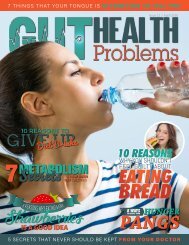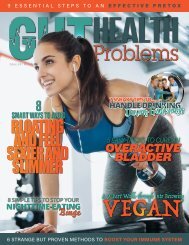Gut Health Problems - September 2017
In the eighth issue of Gut Health Problems, we have an overview of the vast benefits of probiotics, a checklist of foods rich in zinc, an intro to determining if you have fiber deficiency, and more. Intestinal discomfort, whether chronic or occasional, is something worth taking the time to prevent. And while we all have those foods that give us problems, you may actually be able to make a change that makes a bigger difference than you ever imagined.
In the eighth issue of Gut Health Problems, we have an overview of the vast benefits of probiotics, a checklist of foods rich in zinc, an intro to determining if you have fiber deficiency, and more. Intestinal discomfort, whether chronic or occasional, is something worth taking the time to prevent. And while we all have those foods that give us problems, you may actually be able to make a change that makes a bigger difference than you ever imagined.
You also want an ePaper? Increase the reach of your titles
YUMPU automatically turns print PDFs into web optimized ePapers that Google loves.
vital role in the gut including bulking/laxation and hastening ‘transit’ through the<br />
gut (ie. roughage), stimulating the selective growth of certain beneficial gut bacteria<br />
(ie. prebiotic), and slowing the rate of absorption from the small intestine (eg. lower<br />
the glycemic and insulinemic response). Here are answers to some frequently asked<br />
questions about both dietary fiber and natural prebiotics.<br />
These 9 pointers will help you to avoid depression caused by a poor diet. That’s right, it can happen to<br />
anyone.<br />
<br />
CLICK HERE TO LEARN MORE<br />
1<br />
WHAT ARE THE CHARACTERISTICS<br />
OF A PREBIOTIC?<br />
A prebiotic has three main characteristics.<br />
It is a source of food for one or more<br />
strains of beneficial bacteria. It must<br />
remain undigested until it reaches the large<br />
bowel. And lastly, it modifies the colonic<br />
microbiota in such a way that contributes<br />
to the health and well-being of the host.<br />
Unlike probiotics in which beneficial strains<br />
are introduced into the gut, the aim of<br />
taking prebiotics is to promote the growth<br />
of good bacteria that are already in the<br />
gut by increasing their food supply. Hence,<br />
taking probiotics, either through fermented<br />
foods or supplements, does not negate the<br />
effects of prebiotics, and may in fact be<br />
complementary. Read on for a list of foods<br />
that are naturally high in prebiotics.<br />
2<br />
WHAT ARE SOME FOODS THAT ARE<br />
NATURALLY HIGH IN PREBIOTICS?<br />
Dietary fibers classified as having<br />
high prebiotic effects includes inulin,<br />
fructo-oligosaccharides (fructans , FOS)<br />
and galacto-oligosaccharides (GOS).<br />
Vegetables include Jerusalem artichokes,<br />
chicory, garlic, onion, leek, shallots,<br />
spring onion, asparagus, beetroot, and<br />
more. For fruits, try custard apples,<br />
nectarines, white peaches, persimmon,<br />
tamarillo, watermelon, and rambutan.<br />
Nuts and seeds include cashews, pistachio<br />
nuts. Chickpeas, lentils, red kidney beans,<br />
baked beans, and soybeans are excellent<br />
legumes. Dont forget bread, cereals<br />
and snacks either: barley, rye bread, rye<br />
crackers, pasta, gnocchi, couscous, wheat<br />
bran, wheat bread, and oats.<br />
40<br />
<strong>September</strong> <strong>2017</strong>

















